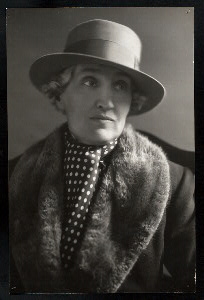So the short answer to last week’s crocodile mystery is that this is a picture of Gwen Lally in the role of Henry V:

How did I know that’s who this was? Well, click on the image and you’ll be taken to the file in Luna, where the metadata clearly indicates that it is “Gwen Lally as Henry V” and the bottom of the image (which I trimmed off for the crocodile post) is labelled “Henry V.” But that’s about all the information it provides, aside from the call number “Scrapbook B.67.1.” Because the Folger Theatre is currently staging Henry V, I was looking through our digital image collection to see what images we had of actors in the role of Henry. I was struck by this one, since it was the second one in our digital collection of a woman playing the role of Henry V (the first is from the first half of the 19th century and shows “Mrs Egerton as Henry the Vth”). While there are certainly plenty of male parts that were played by women over the centuries—Sarah Siddons playing Hamlet and Charlotte Cushman playing Romeo come immediately to mind—but I wasn’t aware of Henry V being one of those roles.
There was something else, too, that struck me about the image, and that’s the odd quality of it: it looked like an image taken from a magazine, not from a photograph. And so I called up the scrapbook and set to work.
The scrapbook is, as you’ll see from the slideshow, full of clippings about and images related to the play (click on the thumbnails above to open up the slideshow). It’s not clear who compiled it; the dealer’s letter doesn’t name the maker. But it was certainly completed before 1925, when it was offered to Mr Folger, and a quick glance suggests that most of the clippings date before 1920.
The image of Gwen Lally comes in the section of the scrapbook devoted to images of actors in the play, and looking at it in the scrapbook itself, it’s clear that it was a clipping from a magazine or newspaper, rather than a photograph:

It doesn’t shed a lot of light on the specifics of this performance, but it does reveal a great deal about its circumstances, clearly tying in the presence of a woman in the role of the English king with the vacuum left by men fighting in Europe. While the scrapbook does indicate a date for this clipping (1916, which corresponds with the text’s account of this happening during the tercentenary of Shakespeare’s death), it doesn’t provide any further details about where the clipping came from. The tone is a bit snarky: the climax of difficult and uncongenial activities for women is playing Henry V. (I’m not sure that really is that hard for women to do, especially given the long history of women playing male parts in Shakespeare’s plays, though I suppose the fashion of seeing Henry as an ideal English king might put particular pressures on that performance.)
I haven’t been able to work out quite when and under what capacity Lally played Henry. She was a member of the Old Vic’s tercentenary celebrations, and it’s possible that she played Henry in that capacity. Gordon Williams suggests, in his book British Theatre in the Great War: A Reevaluation, that she reprised the role of Henry in May 1917 during a matinee performance at the Ambassadors. ((Gordon Williams, British Theatre in the Great War: A Reevaluation (Continuum P, 2003) p270. Williams cites two articles from The Era (10 May 1916 and 30 May 1917) as his source for this, but I haven’t been able to access those articles to see what they report. I am grateful to Mitch Fraas for helping me track down that citation.)) Lally was certainly a player in the British theater scene in the first half of the twentieth century. She’s remembered now primarily as a prominent pageant director, the first women to be so. There are some great photographs of her in later life, including this undated one now part of the Billy Rose Theatre Collection at the New York Public Library:
It’s hard to look back at that picture of Lally in 1916 without knowing of her later success in taking on jobs formerly held by men. When I see that she produced an all-female Henry VIII in 1924, or when I look at the portraits of her with a hairstyle that looks very much like an eighteenth-century wig worn by upperclass men, it’s tempting to project back onto her Henry and to see a life-long engagement with questions of gender roles. Whether that is true or not, it’s helpful to keep in mind that theater is always as powerful as it is because it speaks to us in our own moment. The Chorus in Henry V opens the play asking the audience to let the actors, “ciphers to this great account, / On your imaginary forces work” but it is also true that it is the audience who works their imaginations on the actors, bringing their sense of the world to the theater’s fiction. Whether Lally’s 1916 performance as Henry V was a precursor to later gender rebellion or not, it was certainly indicative of a world that was struggling with how to continue even as war was going on and men were fighting and dying.
Update (February 10, 2013): Mitch Fraas kindly looked up some more details in The Era‘s annual play index and found two productions of Henry V for 1916, but neither lists Gwen Lally as a cast member. I’m inclined to think her performance might have been a one-off, part of a festival or special occasion. If anyone has full access to The Era, I’d love to know what is in the two articles that Williams cites in his account of Lally’s playing Henry V: 10 May 1916 (p21?) and 30 May 1917 (p9).
